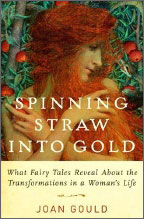 |
 Joan Gould
Joan Gould
Spinning Straw into Gold
Reviewed by: Serena Trowbridge © 2005
Random House
US Hardback
ISBN: 0-394-58532-1
402 Pages; $25.95
Date Reviewed: 28th December 2004
Index:
Non-Fiction
Fantasy
At some point in their lives, everyone is Snow White, Sleeping Beauty or Cinderella, Joan Gould claims convincingly in Spinning Straw into Gold. Perhaps you have long suspected that there is more to traditional "children's" tales than Disney; that Pygmalion is really Cinderella, and that these ancient tales hold secrets and answers about the human condition which are enlightening, if not key, to our growth and development. Gould lays out for us all this and more. She starts by asking "What's your favorite fairytale?" which lends a slight sense of teen magazine quiz to the book, but helps the reader, especially the reluctant reader, to engage quickly with the book's main thoughts and purposes, and discusses a woman who chose Rumpelstilskin, an unusual choice, and what made this woman choose it. (Mine is Rapunzel - I nearly wore the book out when I was a child - and Gould offers unsurprisingly Freudian interpretations of this, of towers and long hair relating to sexuality).
However there is much more to the book than that. Drawing on the contrasts between retellings of the tales, the social developments behind Perrault's respectable eighteenth century versions, the bloodier tales of the aptly named Grimm brothers, and the saccharine reflections of Disney, all possible divergences are considered and put in their place. The earlier, ancient myths on which many fairytales are based also are considered in detail, including a detailed look at the legend of Demeter and Persephone, from the point of view of a mother who has lost her child to adulthood, and a fascinating and logical parallel between Sleeping Beauty and the tale of Brunhilde immortalized by Wagner's Ring Cycle.
However it is the psychological interpretations which will lend the book its popular appeal. Gould draws on Bruno Bettelheim's excellent Freudian analysis of fairytales, The Uses of Enchantment, and adds plenty of analysis and chatty opinion of her own to point out the hidden side of fairytales. These tales have traditionally been the province of women, who told them to their children, especially daughters, and seem at first sight to promote traditional, patriarchal views of a society which represses women and celebrates the all-conquering male hero. However, Gould subtitled her book "What fairytales reveal about the transformations in a woman's life" with good reason, for, she argues, the secrets of women's inner lives are all codified in socially acceptable fairytales to be handed down through the generations.
The book is divided into three parts: Maiden, Matron and Crone, to reflect the fairytale stages of women's lives. The first, Maiden, examines tales where a young woman's life is transformed. This includes Snow White, Cinderella and Sleeping Beauty. All are changed by a dark force, in two cases represented by a wicked step-mother. This apparent representation of evil, however, is a neutral force of nature and time, which acts as the instigator of necessary change, forcing the child to grow into a woman by leaving behind her childhood and family. The onset of sexuality and the subsequent loss of innocence brings with it the certainty of eventual death after she passes through the stages of matron and crone, which is why the force is represented as dark or evil. The child-becoming-woman deals with the change in a number of ways, including sleeping, or becoming unconscious, which, according to Gould, is not the passive path it might seem; or by working through it, like Cinderella, who demonstrates her independence and strength of character, not to mention her ability to survive on her own.
Not only does Gould examine the connotations and meanings of fairytales, she also looks at other relevant examples, in literature, in society, and in her own life (which I find hardest to deal with as the rest of the book is reasonably detached in tone and I find her personal reminiscences do not sit easily here). These include Jane Eyre, Pretty Woman, and the case of Lorena Bobbitt. Gould's gift is in making her subject matter seem relevant to her audience: women will relate easily to this book, men would do well to read it; and if you have an interest in other areas, such as cultural or media studies, mythology, literature or psychology, this will be an intriguing read. To be honest there were moments when I thought "No!" That's too far-fetched!" but on the whole Gould's arguments are readable and compelling. You won't agree with all of it - there's a bit too much about a woman's biology compelling her toward motherhood for my liking - but where's the fun in agreeing with everything? Read, argue and enjoy!
|
 |
